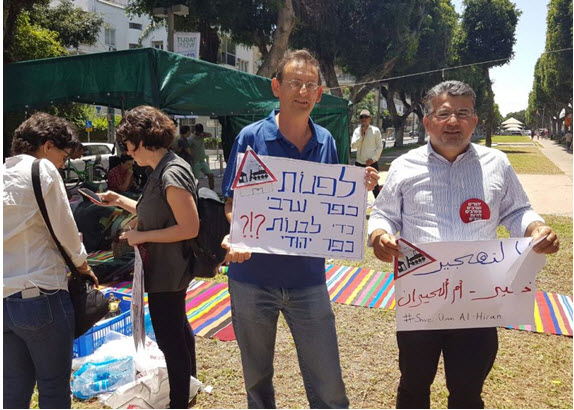At the initiative of “Standing Together,” Arab-Bedouin set up a protest tent on Tel Aviv’s central Rothschild Boulevard on Friday, May 20, in an effort to highlight the plight of two unrecognized villages in the Negev slated for demolition.

Hadash MKs Dov Khenin and Youssef Jabareen near the protest tent on Tel Aviv’s central Rothschild Boulevard on Friday, May 20 (Photo: Al Ittihad)
Umm el-Hiran, home to nearly 500 people, was established by the Bedouin al-Qia’an tribe in 1956 in coordination with the Israeli army, after nearly a decade of dispute. Following the 1948 War, the tribe members were evicted by Israeli soldiers from their homes in the northwestern Negev, near Kibbutz Shoval, and were serially transferred to various temporary locations until finally being moved to the current site of the village. The story of the neighboring village of Atir is very similar. Today, a new Jewish town, to be named Hiran, is planned for construction in place of Um el-Hiran and Atir. Initially, the new community will include 2,500 housing units for mostly religious Jewish families.
The Bedouin residents of Um el-Hiran and Atir have appealed their eviction and destruction of their villages through the court system, but their claims have in large part been rejected. The courts have ruled that these actions do not constitute discrimination, as the Bedouin could theoretically live in the new town as well. (However, this ruling disingenuously ignores the right of community associations in Israel to reject applications from persons desiring to reside there if the applicants are considered by the association to be “incompatible with the life of the community.”) The final appeal to the Supreme Court to keep their villages from being demolished was rejected in January.
Speaking at Friday’s event in Tel Aviv, Hadash MK Youssef Jabareen (Joint List) said: “There has got to be a lot of insensitivity and numbness not to think about the uprooting of 1,500 people.” Jabareen maintains that the case of Um el-Hiran is special because it undermines the usual claims made by the state before the evacuation and destruction of an unrecognized village: “The government usually raises two arguments against the Arab-Bedouin communities in the Negev: that the residents invaded the land or that there isn’t a technical planning option to establish a legal settlement. In the case of Umm al-Hiran, neither of these holds up,” he said.
MK Jabareen continued: “The court ruled that the residents were transferred to the area by state authorities. In addition, the fact that the authorities are planning to build a new settlement in the same place proves that local planning is an option. Under these circumstances, the facts tell the whole story.”
Umm el-Hiran has become a flashpoint in the battle for civil rights of Arab-Bedouin in the Negev. The villagers’ struggle was championed in 2013 by Adalah, the Legal Center for Arab Minority Rights in Israel, because of the perceived strength of their claims to the land. The courts have ruled, however, that the villagers were never given property rights to the land, but were meant to be moved there as a temporary solution. In the last couple of months, two key events have taken place in the Negev, not far from Umm al-Hiran, as a show of solidarity with its residents: The central commemoration of Land Day, this year marking the 40th anniversary, (March 30) and the 19th annual March of Return (May 11).
Related:


